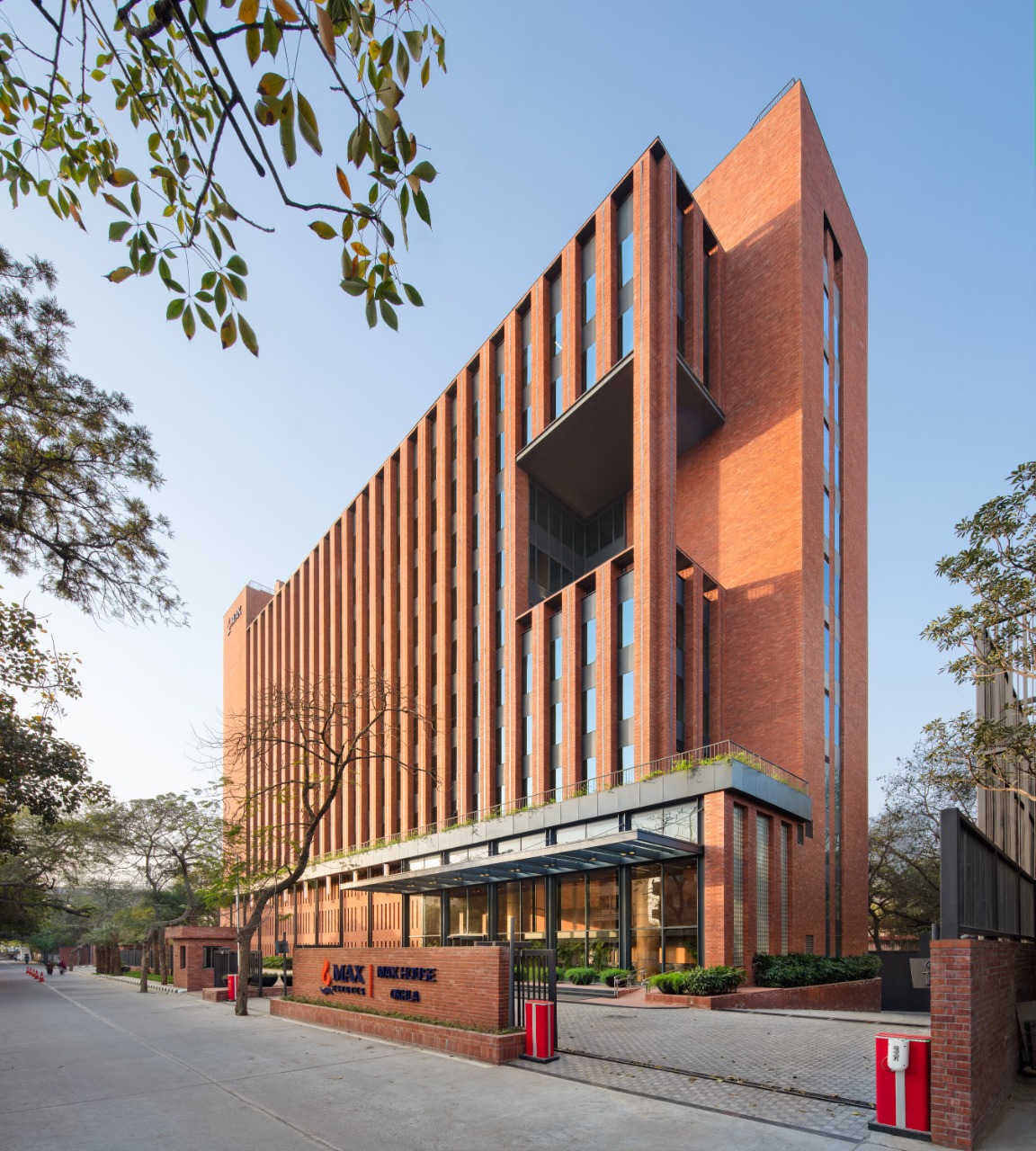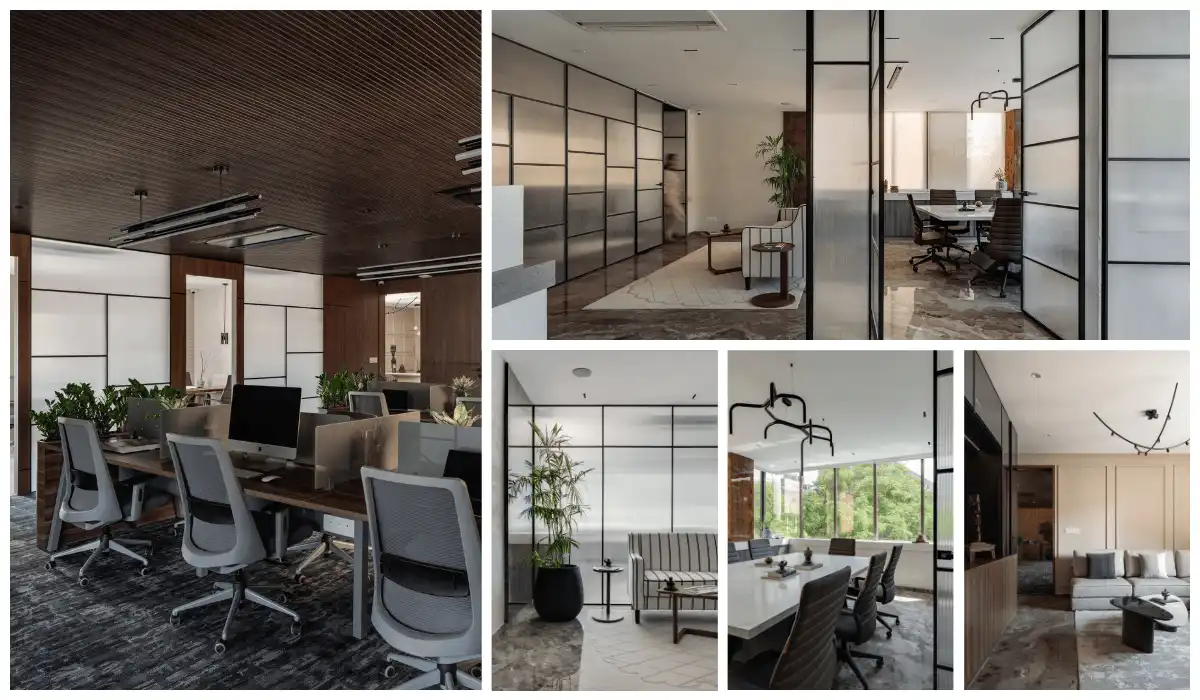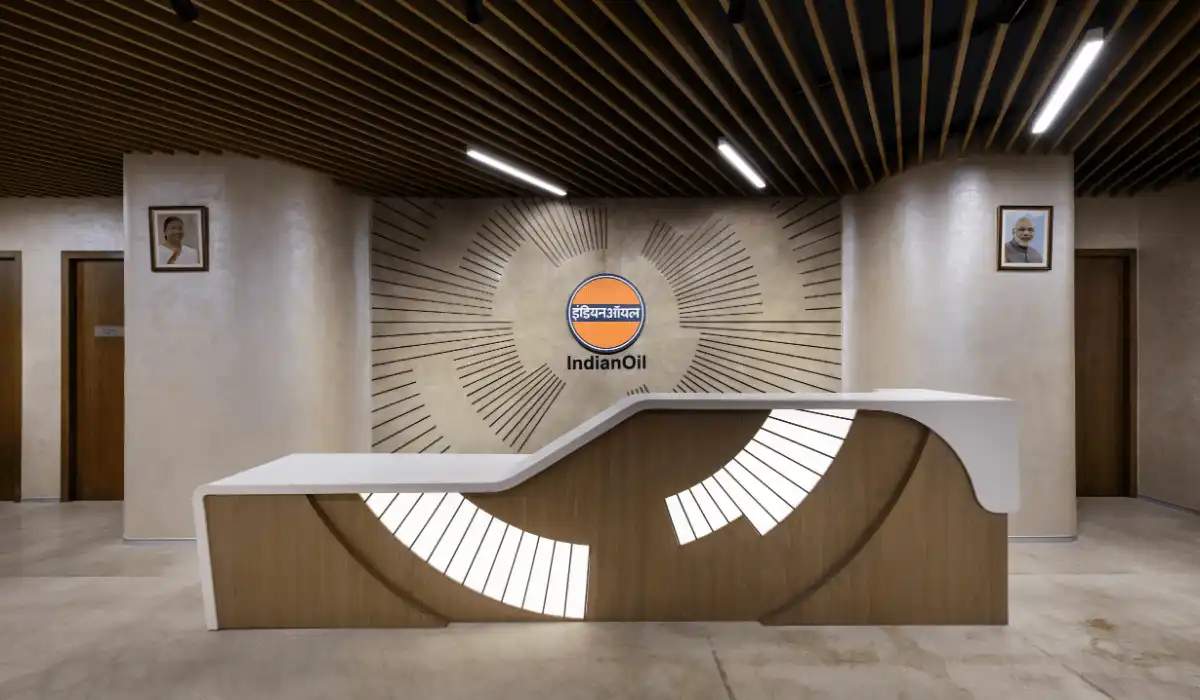Max House is a corporate campus developed by Max Estates, and designed by the architecture firm, Studio Lotus. Located in New Delhi’s Okhla industrial area, the development comprises two multi-tenant buildings placed within a verdant campus—two new towers designed to accommodate a myriad of workspaces and an existing building to be adapted into a community hub that integrates the ground plane of the towers.
Distinguishing itself from its neighbours while remaining firmly embedded in its industrial context, the design vocabulary of Max House extends the narrative set by the old Modi Flour Mills in the vicinity and adapts it for a contemporary workspace.
The Brief
Max Estates’ project brief succinctly underscored the need for a multi-storey office building that would ease into the landscape and nod to its context while aiming to set a benchmark for timeless architecture. The client expressed a desire for the building to echo the brand’s underlying design philosophy rooted in sustainability, resilience, and environmental harmony. The building was to be designed in a way that its architecture and interior expression would reflect responsible sourcing and use of materials and unite it with state-of-the-art workspaces and high-performance systems.

The Context
The site adjoins a bustling thoroughfare, sitting across from an east-west metro corridor, and is a stone’s throw from old industrial buildings such as the Modi Flour Mills and the Baha’i House of Worship, an iconic landmark and tourist attraction. This presented an opportunity for the studio to determine the development’s overall design vocabulary.
Since the development is in proximity to the Yamuna floodplain, the high water table meant that soil conditions in the area would prove to be unfavourable for deep excavations. Additionally, traffic impact analyses necessitated the need for a two to three-basement deep vehicular parking, thus posing an unusual challenge for the design team.

The Design and The Planning
To account for vehicular parking for the eight-storey Block A that was to come up on the site, a parking podium was devised that simultaneously opens up volume for the creation of a spacious triple-height reception lobby at the ground level. The resultant intervention also optimizes vistas — while the reception lobby offers occupants views of lush vegetation flanking the building, the terrace level from the first floor and onwards afford virtually unimpeded views of the Baha’i House of Worship, and the skyline beyond. Moreover, the podium has so been configured, along the building’s northwest, that its height is roughly the same as that of the adjacent railway colony, thereby maximizing views along this part of the building as well.
The buildings are planned to create a wide promenade on the ground level, to facilitate vehicular access up to the building line. The site periphery, in turn, has been reserved for pedestrian access. This access has been transformed through two primary interventions — the setting back of the site boundary to cede space to the city and the neighbouring traffic, and the softening of the site boundaries through landscaping to enable greater physical and visual connection between the complex and its immediate context. Through the formation of this expansive, almost porous forecourt, Max House integrates itself with its surroundings, a marked departure from typical gated commercial developments.


The Facade
Distinguishing itself from its neighbours while remaining firmly embedded in its industrial context, the design vocabulary of Max House extends the narrative set by the old Modi Flour Mills in the vicinity and adapts it for a contemporary workspace. The tower’s façade references the Flour Mills building through its distinctive bands of alternating brick and glass, punctuated by spandrel panels, deep-set balconies and community terraces. While the ground floor is primarily allocated for the podium parking spaces, the first floor features extended terraces, doubling as an elevated park for the users.

The tower features a floor-to-ceiling height of 3.75 metres. The floor plates and the modulating façade have been designed to ensure optimal daylight penetration without concurrent glare, almost eliminating the dependence on artificial means of lighting in the day. The lift and service cores are positioned along the two ends of the buildings, creating an open, rectangular floor plate that allows for maximum flexibility in terms of use. The floor plate configuration, in conjunction with the facade’s significantly low wall-to-window ratio of 60:40 and shading spandrels to cut down solar glare, significantly elevate the passive design parameters of the building, a unique proposition in new-age office building design. The rooftop is designed to accommodate an event space and al fresco dining while providing visitors panoramic vistas of the surrounding landscape.
The Interiors
The design scheme extends the expression of exposed brickwork into the interiors, injecting spaces with a natural, ‘handcrafted’ appeal. While brickwork and glass blocks create the retro chic approach to the interiors of the triple-height lobby, neutral tones of stone and veneer imbue the surfaces with understated elegance.

Sustainability
A collaboration with ROHA for the precinct’s landscape design aimed to harness existing resources, i.e. native vegetation and water, and mitigate the heat island effect. The interventions include an efficient stormwater management network as well as on-site water rainwater management treatments such as the integration of bioswales, infiltration trenches, rain gardens, bioretention areas, and open grid pavers in hardscaped areas.
The building envelope is designed using a two-pronged strategy to regulate the ingress of heat. The façade is composed of hollow brick masonry, insulated spandrel panels, and double-glazed glass units, significantly lowering operating costs. The narrow floor plates ensure that over seventy-five per cent of the occupied floor area receives optimal daylight across all building floors. Spill-out areas facilitate fresh air circulation to occupied spaces by at least thirty per cent above the minimum rates required by the American Society of Heating, Refrigerating and Air-Conditioning Engineers (ASHRAE) Standard 62.1-2010. As many as eighty-two high solar reflective index (SRI) tiles will be installed on the roof to minimize the impact on the micro-climate and reduce heat gain and loss through the built volume.
Through the integration of passive design principles, use of renewable and low-impact materials and technology to optimise both energy and water consumption, the building has received a LEED GOLD certification.
Also Read : Dhyey Chag: Transforming Realty and Architecture in Jamnagar (biltrax.com
Studio Lotus
Email: business@studiolotus.in
Contact: + 91 – 11 4057 0808
Photo Credits – Noughts & Crosses
Note: The text description is provided by the architecture/interior design firm.

Biltrax Construction Data is tracking 25,000+ projects on their technology platform for their clients.
Get exclusive access to upcoming projects in India with actionable insights and gain a competitive advantage for your products in the Indian Construction Market.
Visit www.biltrax.com or email us at contact@biltrax.com to become a subscriber and generate leads.
Disclaimer: The information contained herein has been compiled or arrived at, based upon information obtained in good faith from sources believed to be reliable. All such information and opinions can be subject to change. The image featured in this article is for representation purposes only and does not in any way represent the project. If you wish the article to be removed or edited, please email editor@biltrax.com.
Discover more from Biltrax Media, A Biltrax Group venture
Subscribe to get the latest posts sent to your email.






















